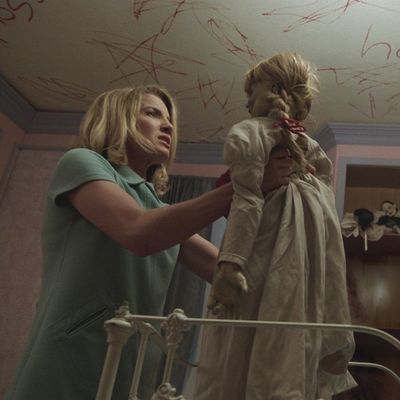
The possessed doll named Annabelle made a notable but tangential appearance in last year’s very scary The Conjuring, which was otherwise about a different case involving the Warrens, the husband-and-wife team of real-life paranormalists who eventually brought the doll under control. (You can find out more about the “real-life” Annabelle here.) The Warrens aren’t in Annabelle, but it does begin by replaying that earlier film’s opening scenes, in which a couple of young nurses related their experiences with the devil doll in question. It’s an odd way to start, though, because the film then flashes back and we never hear from these nurses again. The bulk of the story concerns a young married Santa Monica couple and the creepy forces that swirl around their doll and that want their child.
So many horror films turn on depictions of maternal neuroses. They place their female characters in worlds where every other being — real, imagined, or somewhere in between — has staked a claim on their young children. Maybe the elemental nature of the bond between mother and child inspires these stories. Or maybe it’s just an easy shortcut to grabbing our attention: Who, after all, is more worth protecting than a mother and her baby? Who is somehow both more vulnerable and more willing to fight back?
That’s a pretty familiar setup, and Annabelle is a pretty familiar movie. Too familiar. After a couple of possessed cultists attack the pregnant Mia (Annabelle Wallis) at home and some Jiffy-Pop popcorn almost causes the house to burn down (hey, it happens!), she and her husband John (Ward Horton) move to an apartment, at which point the real fun starts. Eventually, it becomes clear that there are demonic spirits who have eyes for the couple’s newborn daughter, Leah, and they’re playing off the mother’s protective instinct to try and convince her to give the child to them. Because that’s what evil spirits do.
Annabelle starts off confidently. Director John R. Leonetti was the cinematographer of The Conjuring and the Insidious films, and he knows how to use the camera in unexpected ways. In The Conjuring, the camera followed the characters with a genuinely unnerving persistence; here, it makes a couple of effective early efforts to play with perspective and limited sight lines. An early scene involving a brutal crime at a neighbor’s house, seen through a distant window from an adjoining house, is appropriately terrifying.
But while there are other decent chills scattered here and there — one in particular involving a stalled elevator — what we mostly get in Annabelle is what we’ve gotten from so many other horror films: creaking floors, funky white-robed figures, home appliances that go off on their own, mysterious writing that shows up in mysterious places. It’s all repetitive and tired — like discarded ideas from a better horror movie. Even Annabelle the doll seems mostly cursory to the horror at hand; besides, of course, the obligatory zooms into its creepy face as the soundtrack quavers and groans with atonal strings.
What’s worse, the film does nothing with that aforementioned maternal instinct, even though it keeps referencing it. We keep waiting for Mia to turn the tables, to fight back, to protect her child, but she’s mostly helpless. The movie is an endless series of sufferings, tied together loosely with a tired reiteration of the usual mumbo-jumbo about demonic possession and whatnot. So much so that I felt bad for these actors playing the couple. As Mia, Annabelle Wallis suffers nobly, while Ward Horton, who will one day surely win an Oscar for The Daniel Tosh Story, spends most of the movie running to the rescue.
Familiarity is not always a bad thing, though. The Conjuring breathed new life into old clichés; it showed that those creaking doors and possessed closets and white-robed figures still had the power to scare us. But that was a movie made with sensitivity and purpose. The blunt, lifeless Annabelle, on the other hand, sucks that life right back out.
* This piece has been updated with the correct last name of the family in Annabelle. They are the Warrens, not the Millers.


